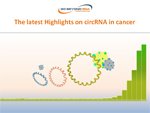Order Guide
Publications >>
LncRNA&mRNA Epitranscriptomic Array
Xiong Y W, et al. (2024) Nature Communications
[PMID: 38355624]
Small RNA Modification Array
Zhang J, et al. (2024) Circulation Research
[PMID: 38747146]
Circular RNA Array
Hu Y, et al. (2024) Molecular Cancer
[PMID: 39695693]
Promotions >>
Brochures >>
Arraystar GlycoRNA Array
Discover the Pivotal Roles of Glycosylated RNAs in Cancer and Disease

Webinars >>
Why and How to Study GlycoRNAs NEW!

R-Loops: An Active Player in Cancer and Diseases NEW!

The Latest Highlights on CircRNA in Cancer

New Discoveries in m6A Epitranscriptomics

Raising the Bar of Multi-transcrptomic Profiling of Small RNAs

Extrachromosomal Circular DNAs NEW!
– The extraordinary eccDNAs in cancer and diseases

Efficient Labeling Method to Achieve High Sensitivity and High Accuracy of SE-LncRNA Quantification
Super-enhancer lncRNAs are generally labile and short in half-lives. They can function at low copy numbers per cell to activate the target genes by cis-mechanism. For example, LncRNA-HOTTIP can activate the HOXA gene cluster with an average of less than one copy per cell.
To accurately detect and quantify the transient, low level SE-lncRNAs, Arraystar scientists have developed an efficient and robust linear amplification method to generate ample fluorophore-labeled cRNA for both polyadenylated and non-polyadenylated transcripts. In this method, an optimized mixture of oligo(dT) and random primers, each containing a T7 polymerase promoter, is annealed to the RNA. The cDNA is synthesized by reverse transcription followed by 5’ adapter annealing and PCR amplification. Finally, cyanine 3- or cyanine 5-labeled cRNA is synthesized by in vitro transcription from the T7 promoter by T7 RNA polymerase (Figure 1).
The labeling procedure greatly increases the cRNA yield from low-abundance or degraded RNA molecules by more than 100-fold over conventional methods.

Figure 1. Arraystar’s cRNA Labeling Procedure. (1) First strand cDNA synthesis and 5’ adapter annealing. RNA is primed by a mixture of oligo(dT) and random primers containing a T7 polymerase promoter and reverse transcribed into first strand cDNA. 5’-adapter is annealed to the 3’-end of the first strand cDNA during the reverse transcription. (2) PCR amplification. Double strand cDNA is amplified using the RT primer and 5’-Adapter sequences by low cycles of PCR. (3) In vitro transcription and labeling of antisense RNA (aRNA). Fluorescently labeled antisense RNAs are synthesized by in vitro T7 polymerase transcription from the T7 promoter using a Cy3- or Cy5-nucleotide substrate. The linear amplification reserves the native transcript levels and copies along the entire length of the transcript without 3’ bias.
Related Services
SE-lncRNA Array service
